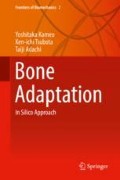Abstract
This chapter describes a two-dimensional computer simulation of trabecular structural changes in a human proximal femur. As described in Chap. 8, local stress nonuniformity is assumed to drive trabecular structural change by surface remodeling to seek a uniform stress state. A large-scale pixel finite element model is constructed for simulating structural changes of individual trabeculae over the entire bone. In the simulation, the initial structure of trabeculae changes from isotropic to anisotropic because of the trabecular microstructural changes according to the mechanical environment in the proximal femur. The apparent structural properties evaluated by fabric ellipses correspond to the apparent stress state in cancellous bone. As observed in the actual bone, a distributed trabecular structure is obtained under a multiple-loading condition. These results demonstrate that trabecular surface remodeling leading towards a local uniform stress state at the trabecular level results in a functional adaptation phenomenon at the apparent tissue level. The proposed simulation model is capable of providing insight into the hierarchical mechanism of trabecular surface remodeling from the microstructural level up to the apparent tissue level.
This Chapter was adapted from Tsubota et al. (2002) with permission from Elsevier.
References
Adachi T, Tomita Y, Sakaue H, Tanaka M (1997) Simulation of trabecular surface remodeling based on local stress nonuniformity. JSME Int J Ser C-Mech Syst Mach Elem Manuf 40(4):782–792. https://doi.org/10.1299/jsmec.40.782
Adachi T, Tomita Y, Tanaka M (1999) Three-dimensional lattice continuum model of cancellous bone for structural and remodeling simulation. Jsme Int J Ser C-Mech Syst Mach Elem Manuf 42(3):470–480. https://doi.org/10.1299/jsmec.42.470
Bagge M (2000) A model of bone adaptation as an optimization process. J Biomech 33(11):1349–1357
Beaupré GS, Orr TE, Carter DR (1990) An approach for time-dependent bone modeling and remodeling-application: a preliminary remodeling simulation. J Orthop Res 8(5):662–670. https://doi.org/10.1002/jor.1100080507
Carter DR, Fyhrie DP, Whalen RT (1987) Trabecular bone density and loading history: regulation of connective tissue biology by mechanical energy. J Biomech 20(8):785–794
Carter DR, Orr TE, Fyhrie DP (1989) Relationships between loading history and femoral cancellous bone architecture. J Biomech 22(3):231–244
Ciarelli TE, Fyhrie DP, Schaffler MB, Goldstein SA (2000) Variations in three-dimensional cancellous bone architecture of the proximal femur in female hip fractures and in controls. J Bone Miner Res 15(1):32–40. https://doi.org/10.1359/jbmr.2000.15.1.32
Cowin SC (1985) The relationship between the elasticity tensor and the fabric tensor. Mech Mater 4(2):137–147. https://doi.org/10.1016/0167-6636(85)90012-2
Cowin SC (1986) Wolff's law of trabecular architecture at remodeling equilibrium. J Biomech Eng 108(1):83–88
Doblare M, Garcia JM (2001) Application of an anisotropic bone-remodelling model based on a damage-repair theory to the analysis of the proximal femur before and after total hip replacement. J Biomech 34(9):1157–1170
Doblare M, Garcia JM (2002) Anisotropic bone remodelling model based on a continuum damage-repair theory. J Biomech 35(1):1–17
Fernandes P, Rodrigues H, Jacobs C (1999) A model of bone adaptation using a global optimisation criterion based on the trajectorial theory of Wolff. Comput Methods Biomech Biomed Eng 2(2):125–138. https://doi.org/10.1080/10255849908907982
Garcia-Aznar JM, Rueberg T, Doblare M (2005) A bone remodelling model coupling microdamage growth and repair by 3D BMU-activity. Biomech Model Mechanobiol 4(2–3):147–167
Hughes TJR, Ferencz RM, Hallquist JO (1987) Large-scale Vectorized implicit calculations in solid mechanics on a Cray X-Mp/48 utilizing Ebe preconditioned conjugate gradients. Comput Method Appl M 61(2):215–248
Huiskes R, Weinans H, Grootenboer HJ, Dalstra M, Fudala B, Slooff TJ (1987) Adaptive bone-remodeling theory applied to prosthetic-design analysis. J Biomech 20(11–12):1135–1150
Jacobs CR, Simo JC, Beaupre GS, Carter DR (1997) Adaptive bone remodeling incorporating simultaneous density and anisotropy considerations. J Biomech 30(6):603–613
McNamara LM, Prendergast PJ (2007) Bone remodelling algorithms incorporating both strain and microdamage stimuli. J Biomech 40(6):1381–1391. https://doi.org/10.1016/j.jbiomech.2006.05.007
Mullender MG, Huiskes R, Weinans H (1994) A physiological approach to the simulation of bone remodeling as a self-organizational control process. J Biomech 27(11):1389–1394
Skedros JG, Baucom SL (2007) Mathematical analysis of trabecular 'trajectories' in apparent trajectorial structures: the unfortunate historical emphasis on the human proximal femur. J Theor Biol 244(1):15–45. https://doi.org/10.1016/j.jtbi.2006.06.029
Tsubota K, Adachi T, Tomita Y (2002) Functional adaptation of cancellous bone in human proximal femur predicted by trabecular surface remodeling simulation toward uniform stress state. J Biomech 35(12):1541–1551. https://doi.org/10.1016/S0021-9290(02)00173-2
Turner CH, Anne V, Pidaparti RM (1997) A uniform strain criterion for trabecular bone adaptation: do continuum-level strain gradients drive adaptation? J Biomech 30(6):555–563
van Rietbergen B, Muller R, Ulrich D, Ruegsegger P, Huiskes R (1999) Tissue stresses and strain in trabeculae of a canine proximal femur can be quantified from computer reconstructions. J Biomech 32(4):443–451
van Rietbergen B, Weinans H, Huiskes R, Odgaard A (1995) A new method to determine trabecular bone elastic properties and loading using micromechanical finite-element models. J Biomech 28(1):69–81
Wolff J (1892) Das Gesetz Der Transformation Der Knochen. Hirschwald, Berlin
Wolff J (1986) The law of bone remodeling (trans: Maquet P, Furlong R). Springer, New York
Xia SL, Ferrier J (1992) Propagation of a calcium pulse between osteoblastic cells. Biochem Biophys Res Commun 186(3):1212–1219
Author information
Authors and Affiliations
Rights and permissions
Copyright information
© 2018 Springer Japan KK
About this chapter
Cite this chapter
Kameo, Y., Tsubota, Ki., Adachi, T. (2018). Functional Adaptation of Cancellous Bone in Human Proximal Femur. In: Bone Adaptation. Frontiers of Biomechanics, vol 2. Springer, Tokyo. https://doi.org/10.1007/978-4-431-56514-7_12
Download citation
DOI: https://doi.org/10.1007/978-4-431-56514-7_12
Published:
Publisher Name: Springer, Tokyo
Print ISBN: 978-4-431-56512-3
Online ISBN: 978-4-431-56514-7
eBook Packages: EngineeringEngineering (R0)

